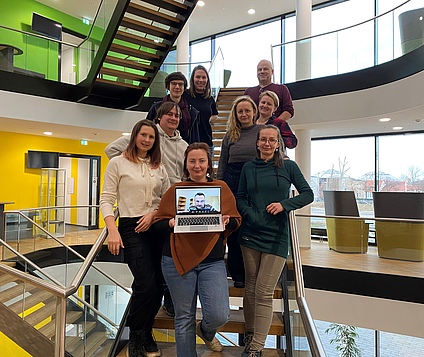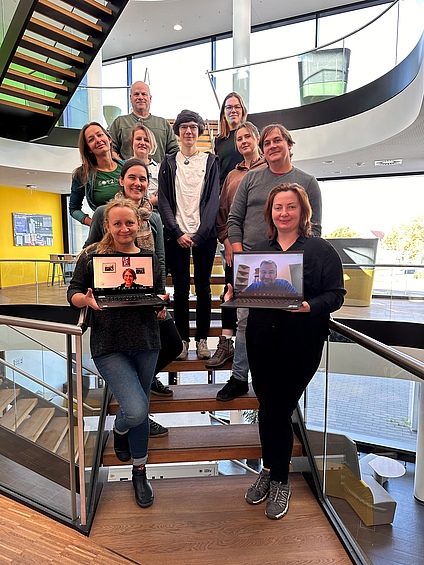sCaleGrassDiv - Do the mechanisms of land-use effects on grassland plant diversity depend on spatial scales and environmental contexts?
First meeting: 30.01.-03.02.2023
PIs:
Anna Kuzemko
Oksana Buzhdygan
iDiv member:
Jonathan Chase
Project summary:
Temperate grasslands are among the richest ecosystems in plant species at small spatial scales (grain sizes) but most degraded by land use. Understanding how land use alters diversity and composition of grassland plant communities across environmental gradients remains limited in several aspects. First, most empirical studies test the diversity responses to ecological drivers at a single grain size, even though strong evidence exists that different mechanisms influence diversity at different spatial scales. The studies testing spatial gradients focus majorly on species number and rarely consider functional traits and other diversity facets. Also, evidence is limited to solely vascular plant communities and specific habitat types, while the comparison across different vegetation groups (bryophytes, lichens) and habitat gradients is required for understanding the generalised patterns and context-dependencies of diversity drivers. Given these limitations the existing results strongly differ in the strength, shape, and even sign of the land-use effects and other environmental drivers, and the spatial scales at which they act. Major source of such divergent findings might be that these drivers operate simultaneously as parts of a whole interacting system, affecting diversity both directly and indirectly. This project will address these gaps by integrating the complex multivariate network of potential diversity drivers (including land use, biogeographic gradients, local site properties), explicitly measured for each plot, and test their effects on plant community composition and different diversity facets across spatial scales. For this we analyze the comprehensive data collected with a standardized sampling at 1638 plots of different grain sizes across various grassland habitats.
In person participants:
Oksana Buzhdygan (Freie Universität Berlin), Anna Kuzemko (M.G. Kholodny Institute of Botany of the National Academy of Sciences of Ukraine), Jonathan Chase (iDiv), Selina Baldauf (Freie Universität Berlin), Olha Chusova (Zurich University of Applied Sciences), Svitlana Iemelianova (M.G. Kholodny Institut of Botany of NAS of Ukraine, Masaryk University), Denys Vynokukrov (M.G. Kholodny Institute of Botany, National Academy of Sciences of Ukraine), Dariia Shyriaieva (M.G. Kholodny Institute of Botany), Emma Ladouceur (iDiv)
Remote participants:
Vasyl Budzhak (Institute of Evolutionary Ecology NAS Ukraine, Kyiv, Ukraine), Britta Tietjen (Freie Universität Berlin)
Second meeting: 06.-10.11.2023
In person participants:
Oksana Buzhdygan (Freie Universität Berlin), Anna Kuzemko ( Institute of Botany, National Academy of Science in Ukraine), Jonathan Chase (iDiv), Emma Ladouceur (iDiv), Selina Baldauf (Freie Universität Berlin), Dariia Borovyk (Institute of Botany, National Academy of Science in Ukraine; Masaryk University), Denys Vynokukrov (Institute of Botany, National Academy of Science in Ukraine; University of the Basque Country UPV/EHU), Svitlana Iemelianova (Institute of Botany, National Academy of Science in Ukraine; Masaryk University), Olha Chusova (Institute of Botany, National Academy of Science in Ukraine), Joana Bergmann (Leibniz Center for Agricultural Landscape Research)
Remote participants:
Britta Tietjen (Freie Universität Berlin), Vasyl Budzhak (Institute of Evolutionary Ecology, National Academy of Science in Ukraine)
3rd meeting: 27.-31.05.2024
PIs:
Anna Kuzemko
Oksana Buzhdygan
iDiv member:
Jonathan Chase
In person participants:
Dariia Borovyk (M.G. Kholodny Institute of Botany National Academy of Sciences of Ukraine), Jonathan Chase (German Centre for Integrative Biodiversity Research (iDiv)), ANNA KUZEMKO (M.G. Kholodny Institute of Botany National Academy of Sciences of Ukraine), Denys Vynokurov (M.G. Kholodny Institute of Botany National Academy of Sciences of Ukraine), Emma Ladouceur (German Centre for Integrative Biodiversity Research (iDiv)), Olha Chusova (M.G. Kholodny Institute of Botany National Academy of Sciences of Ukraine), Joana Bergmann (Leibniz Centre for Agricultural Landscape Research (ZALF)), Svitlana Iemelianova (Masaryk University)



